Lovers of natural adventures, if you want to explore destinations with spectacular scenery, fascinating geological heritage, fauna and flora of rare diversity, while offering you the opportunity to meet local communities with smiling hospitality, walking through Vietnam’s global geoparks will undoubtedly meet your desires for exploration, meetings and sharing.
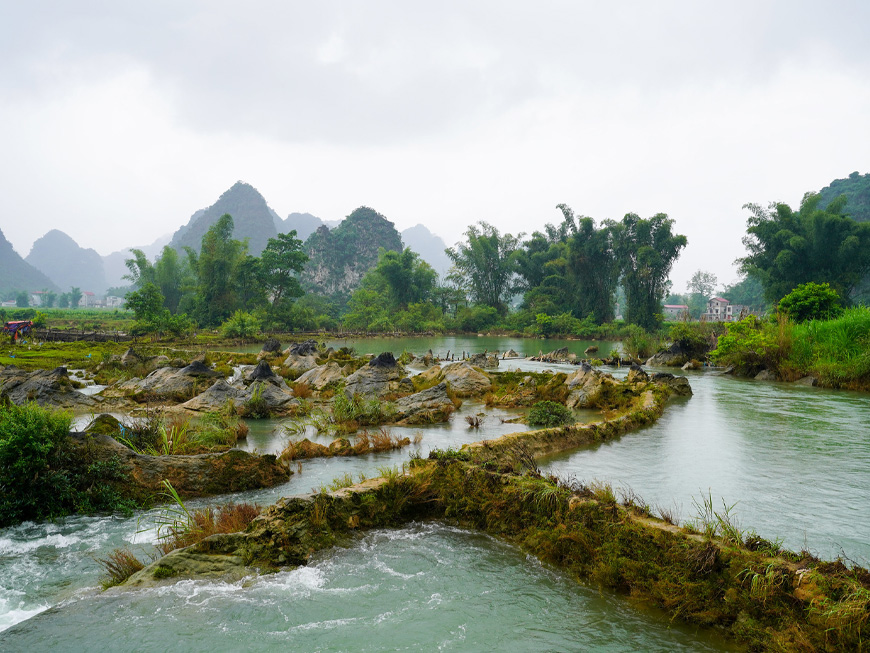
Global Geopark, definition and challenges
The UNESCO World Geopark label is awarded by UNESCO and the Global Network of Geoparks to a territory with a remarkable geological heritage of international importance. The global network of Geoparks sets standards for the conservation of geological heritage, while taking care to preserve local identities and cultures, in parallel with harmonious economic (and tourist) development. The members of the «Global Geopark Network» are committed ửoking together in a dynamic of sharing experiences and cooperation. They meet every two years for a world conference. For your information, the network is divided into 4 sub-networks at the continental level (Africa, South America, Asia-Pacific and Europe). To date, there are 147 Global Geoparks in 41 countries (including 3 in Vietnam).
To conclude this short introduction to UNESCO Global Geoparks, it is very important to emphasize that a geopark is not just a geological park. While it must effectively enhance and preserve an exceptional geological heritage, its main purpose is to explore, develop and enhance the links between this geological heritage and all other aspects of the local heritage, whether they are natural, cultural, or intangible. It is based on three pillars:
- ♦ Preservation, where scientific knowledge contributes to the management, preservation and development of geological resources.
- ♦ Education, mainly driven by geology, is seen here as a vehicle for raising awareness of the environment as a whole.
- ♦ Local development, which focuses on ecotourism and facilitates awareness and understanding of societal issues.
In this dynamic, 3 places in Vietnam have been recognized by UNESCO as global geo-parks. Whether you are a nature lover or intrepid adventurer, a lover of bushy roads or passionate about wildlife, follow the guide to discover the natural charm of Vietnam’s global geoparks!
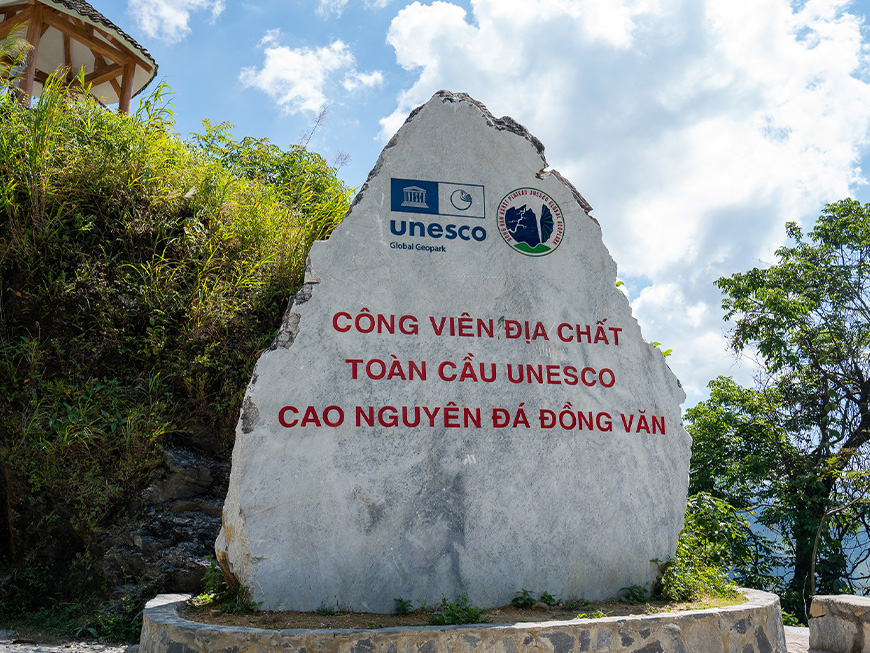 Ha Giang, province of natural charms ©Mr Linh's adventures
Ha Giang, province of natural charms ©Mr Linh's adventuresGeoparks of Vietnam
Dong Van Karst Plateau Geopark (Ha Giang Province)
On 3 October 2010, the Dong Van Karst Plateau officially became the first Global Geopark in Vietnam and the second in Southeast Asia.
The Dong Van Plateau, part of Ha Giang Province, is located in the northernmost part of Vietnam at an average altitude of 1,000 to 1,600 meters and set in a spectacular and mesmerizing decor of majestic karst mountains. In this mineral theater with its harsh and wild beauty, live many ethnic communities each with its traditional culture and folk heritage. Punctuated by enchanting floral seasons, life on the Dong Van plateau takes place in the 4 districts of Quan Ba, Yen Minh, Dong Van and Meo Vac.
Geology enthusiasts (or simply lovers of nature and bushy paths) will appreciate in the Dong Van Geopark the footprints left here by the Earth over its 550 million year old history and 7 different geological periods, including in terms of paleontology, stratigraphy, geomorphology, jagged cliffs, karst peaks and other caves.
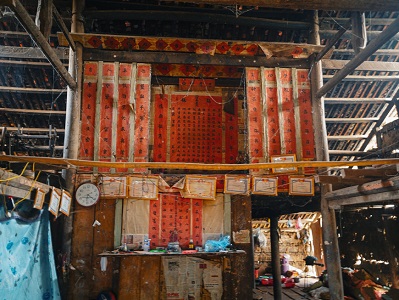 |
| Traditional ethnic stilt house |
In addition to its geological and geomorphological values, the Dong Van Geopark is home to rich and diverse ecosystems with a wide range of endemic and rare flora and fauna. Thus, in the middle of conifers, the Asian black bear plays hide-and-seek with the Southern serow (a mountain goat, with a rather solitary life), under the playful squawks of a multitude of species of birds. In addition, this
UNESCO Global Geopark is known to house a species of primate that was believed to be hugged but which was rediscovered in the early 1990s: the mysterious monkey with the nose turned up of Tonkin, considered one of the 25 most endangered primate species in the world.
But let’s not forget the vibrant cultural values of the Dong Van Geopark, with its mosaic of 17 ethnic communities including the H'mong, Tay, Nung,... Their unique cultural traditions, festivals, crafts, and agricultural practices are intimately linked to the landscapes.
Fascinating land of adventures, passions and encounters, the
Dong Van geopark also offers to discover the sea of clouds beyond the gate of paradise of Quan Ba, offers the hiker the zigzag slope of Bac Sum or the valley of Sung La, glazed with adobe houses hidden in fields of buckwheat flowers. Don’t forget to visit the King of Meo’s Palace, to climb the steps from the flagpole to the Lung Cu flag or to sink into the depths of Lung Khuy Cave… One evening, take the time to taste the local culinary specialties in the old quarter of the ancient village of Dong Van, with its old-fashioned and exotic charm, and one morning, very early, immerse yourself in the colorful and exotic atmosphere of a local market, a moving kaleidoscope of ethnic diversity that makes all the
Dong Van practical information
When and how to get to the UNESCO World Park of the Dong Van Karst Plateau?
Ideally, the geopark of the Dong Van plateau can be visited between October and April, a period with mild and pleasant weather, perfect for
exploring the mountain trails. The romantic and spectacular flowering of buckwheat takes place between October and December. You should also know that from January to February, it is cherry blossom and canola season, while September to October sees the golden season, in other words the rice harvest.
Getting to the Dong Van Karst Plateau Geopark is an adventure in itself! The most common route is to leave
Hanoi, the capital of Vietnam and enjoy the 7-hour journey to destination by bus or private vehicle. Do not hesitate to contact a local agency specialized in the destination for more information and advice.
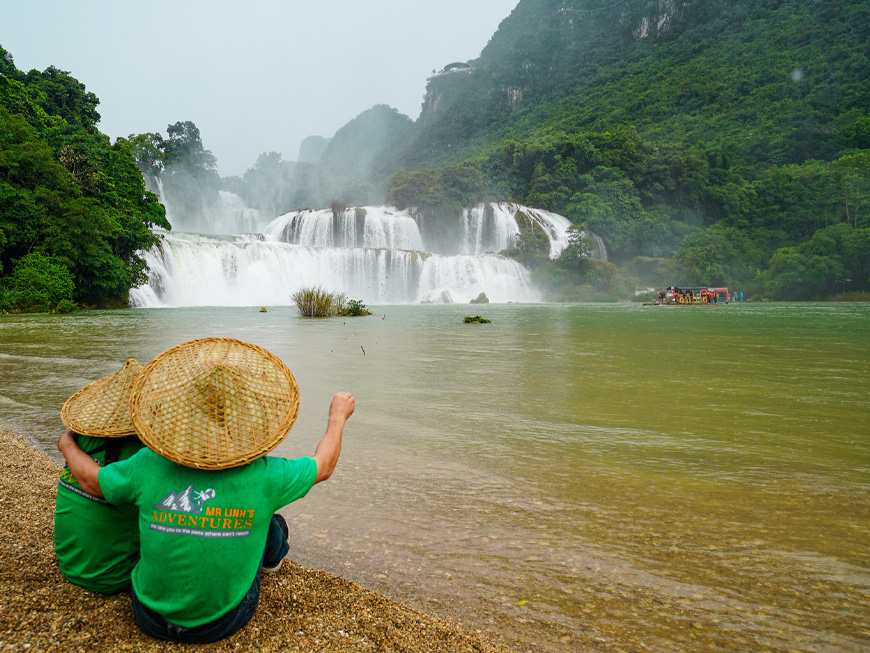
Ban Gioc wterfalls, Cao Bang Province ©Mr Linh's adventures
Non Nuoc Cao Bang Geopark (Cao Bang Province)
Officially recognized by UNESCO as a Global Geo-Park in April 2018, Non Nuoc Cao Bang represents almost half the area of the province of Cao Bang.
The UNESCO Global Geopark Non Nuoc Cao Bang is located in northern Vietnam, about 300 km north of the capital, bordering many districts of Cao Bang province and extending over more than 3,000 square kilometers. Its landscape of karst mountains comes in a deep valley crossed by rivers with fresh and clear waters, shelters lakes with jade reflections, hides caves, fossils, and marine sediments, telling a history dating back more than 500 million years. The diversity of the rocks, but also of the reliefs, testifies to an exceptional geo-diversity, like stopovers on the evolution and the history of the earth crust.
As a
UNESCO Geopark,
Non Nuoc Cao Bang is not only a great geological heritage, it is also the land of 9 ethnic groups with ancestral traditions unchanged for tens of generations. Tay, Nung, Dao, Bo Y and San Chay, among others, live here to the rhythm of their folk festivals, trading sparingly a unique and remarkable craft, each community displaying an astonishing cultural richness, magnified in its popular art.
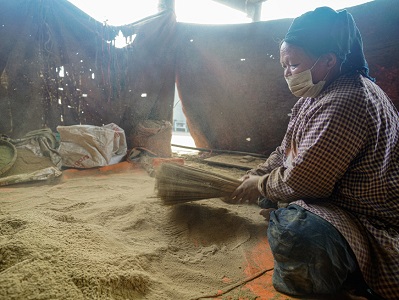 |
| Nung ethnic woman Cao Bang |
Known for its spectacular Ban Gioc Waterfalls, the largest in Vietnam and the world’s 4th largest border waterfalls, Cao Bang Province is also known for having been the scene of many historical facts, especially during the war of independence against the French. No fewer than 200 cultural and historical relics have been listed, including 3 special national relics and 23 national ones. On an
off-the-beaten-path tour of North Vietnam, don’t miss – for example – a visit to Pac Bo Cave, Le Nin Creek, Thang Hen Lake or Nguom Ngao Cave, near Ban Gioc Falls.
Being an integral part of the
Non Nuoc Geopark, the Trung Khanh Endemic Species Reserve is spread over 3 municipalities to accommodate nearly 130 Cao Vit gibbons, one of the rarest primate species in the world. With a little luck, you will also come across bears, deer and other monkeys.
In addition, the area is home to the Phia Den National Park (in Nguyen Binh district), a superb playground for nature lovers. With its rich biodiversity (58 species of fauna and 90 rare species of flora), its extensive primal forests, Phia Den is a destination off the beaten track but easy to access, which will delight all lovers of natural authenticity.
No Nuoc Cao Bang practical information
When and how to get to the UNESCO World Geopark Non NuocCao Bang.
If the region can be visited all year round, it is still better to avoid the rainy season, between March and October. Prefer, if you can, the dry season, from September to April. Solo, you will take a bus from My Dinh bus station or Gia Lam, in Hanoi, for a journey of 8 to 10 hours and a ticket between 8 and 12 USD. Alternatively, you can use the services of a local agency.
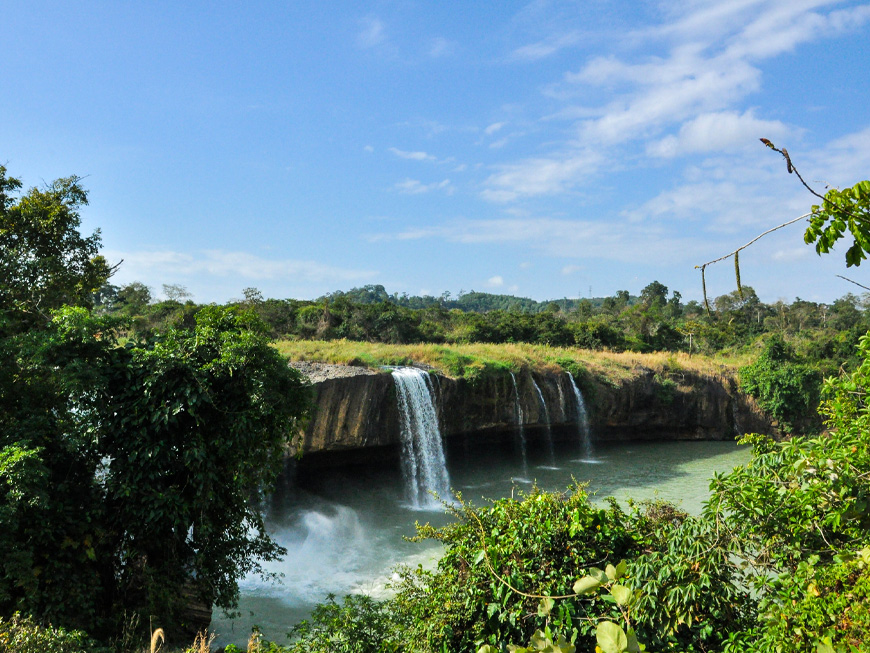 Dray Nur fall, Dak Nong Geopark ©Mr Linh's adventures
Dray Nur fall, Dak Nong Geopark ©Mr Linh's adventuresDak Nong Geopark (Dak Nong Province)
Although it was created in 2015, the youngest of Vietnam’s geoparks was officially recognized as such by UNESCO only on 7 July 2020.
It is in the province of Dak Nong, a province belonging to the central highland’s region, here called Tay Nguyen. Covering an area of more than 4,700 km2, it covers 5 districts and hosts the city of Gia Nghia. With 65 geological heritage sites, including seven world-class, the Dak Nong Geopark summons all the typical values of geology, geomorphology, biodiversity, and cultural heritage of the region. There are nearly 50 caves with a total length of over 10,000 m, the longest volcanic cave system in Southeast Asia. On the surface, the landscape is crisscrossed by waterfalls playing with extinct volcano craters, frozen in basalt… all bathed in an atmosphere at once majestic and serene, wild, and peaceful.
This setting of choice for adventurers lovers of nature and other explorers with natural curiosity, houses and preserves a rich system of flora and fauna, many of which are listed in the Vietnam Red Book and in the World Red Book. In addition, it contains valuable prehistoric artifacts, dating from about 6,000 to 7,000 years ago.
Coming to the Dak Nong Global Geopark, be sure to make a detour to Ta Nung National Park, Lieng Nung Waterfalls, D'ray Sap, Trinh Nu, Gia Long and Yok Don National Park, with its solitary and majestic beauty.
Dak Nong is also famous for being the site of the discovery of what is considered to be one of the oldest musical instruments of humanity: a basalt lithophone, shaped more than 3,000 years ago by prehistoric men obviously music lovers… A very particular sensitivity that we find nowadays in the rich ethnic identity of Dak Nong. Originally the land of the three communities M'Nong, Ede and Ma, Dak Nong welcomed, in the late 1970s, many inhabitants from other provinces, until today hosting more than 40 ethnic groups, the vibrant heart of the “Cultural Space of Gongs in Central Highlands of Vietnamk”, recognized by UNESCO as intangible cultural heritage.
Exploring the Dak Nong Geopark is to plunge into the heart of the Land of Sounds, into the «Sounds of the Earth», into the vibrations of the «Rhapsody of fire and water» or the «Concerto of the new wind».
Dak Nong geopark, practical information
When and how to get to Dak Nong UNESCO Global Geopark.
The easiest way is to fly from
Ho Chi Minh City to Buon Ma Thuot (about 1 hour flight) and from there, get to the park, 150 km away, by taxi or bus. If you come from Hanoi, you can land directly on the tarmac of Buon Ma Thuot. Then, a bus will take you to Dak Nong.
Ideally, the Central Highlands can be discovered comfortably between November and May, both for the complicit weather of your explorations, but also for the season of flowers, which gives a bright touch of color to your hikes. Finally, the hottest (and wettest) month is June.